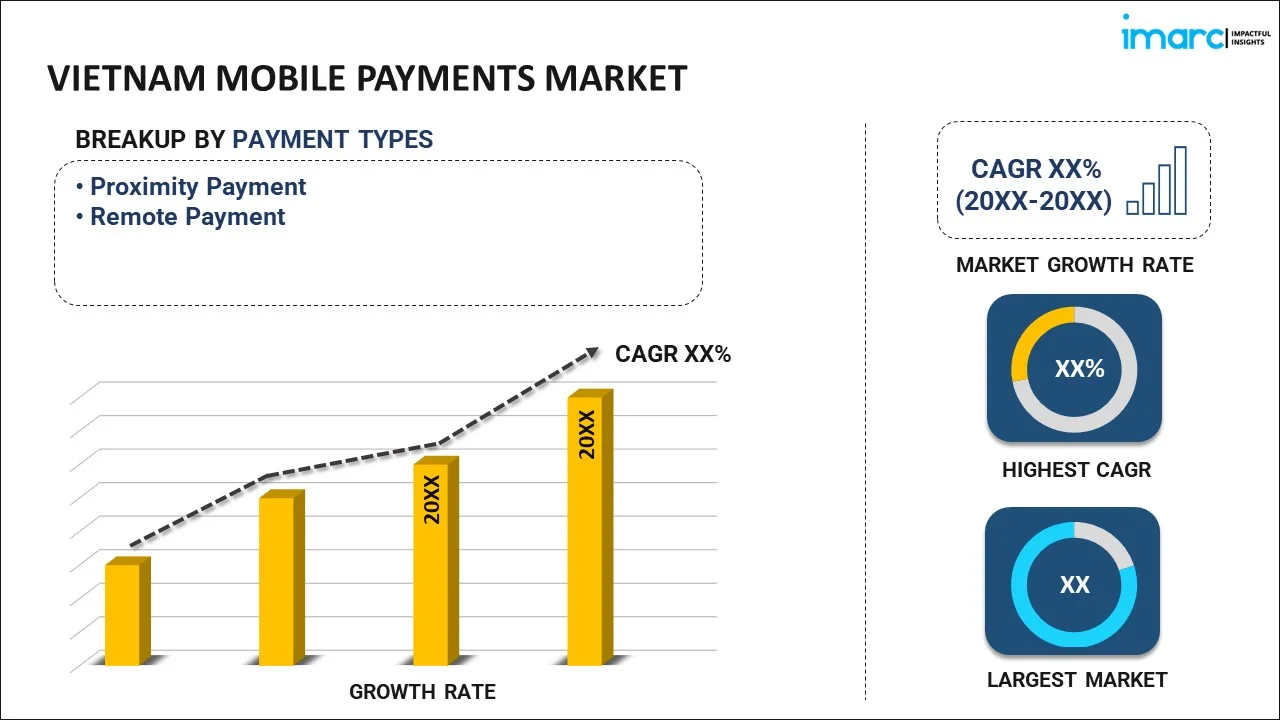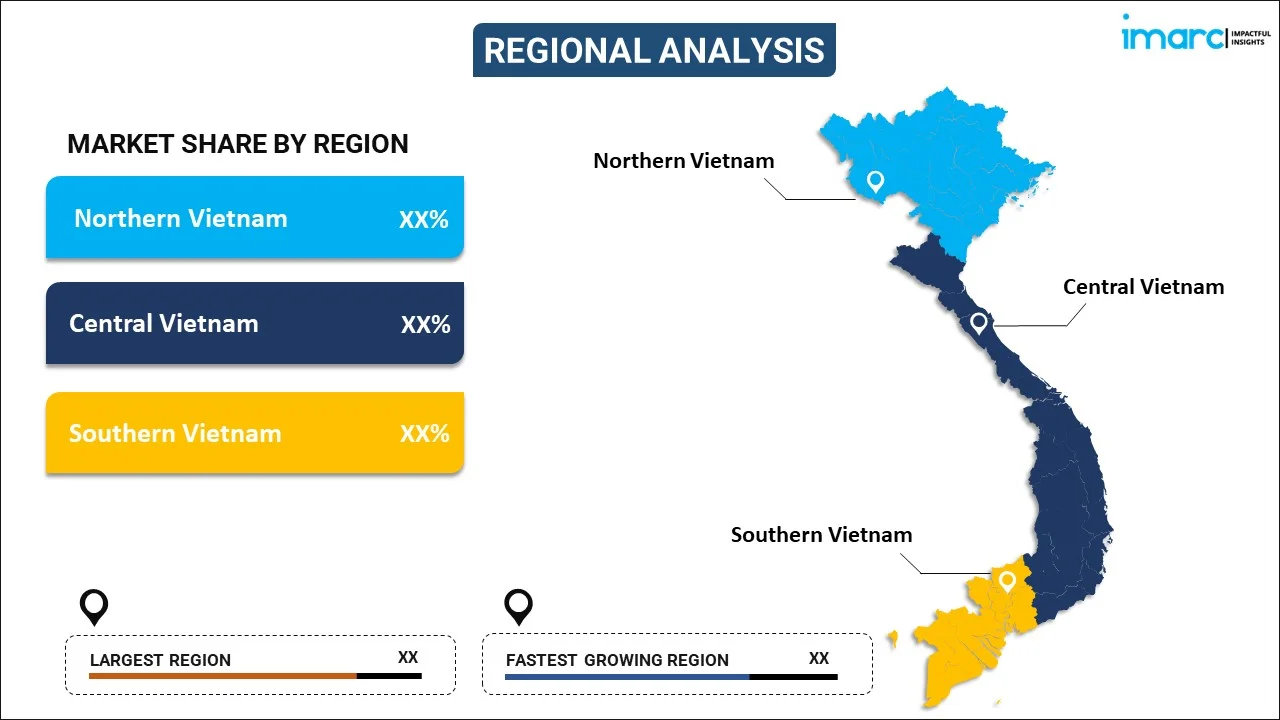
Vietnam Mobile Payments Market Report by Payment Type (Proximity Payment, Remote Payment), Industry (Media and Entertainment, Retail and E-commerce, BFSI, Automotive, Medical and Healthcare, Transportation, Consumer Electronics, and Others), and Region 2026-2034
Market Overview:
Vietnam mobile payments market size reached USD 12.1 Billion in 2025. Looking forward, IMARC Group expects the market to reach USD 35.4 Billion by 2034, exhibiting a growth rate (CAGR) of 12.64% during 2026-2034. The increasing number of tech-savvy individuals, the rising preference for cashless transactions, the growing uptake of mobile payments for P2P transactions, the escalating convenience, and the ongoing digital transformation are some of the key factors driving the market.
|
Report Attribute
|
Key Statistics
|
|---|---|
|
Base Year
|
2025
|
|
Forecast Years
|
2026-2034
|
|
Historical Years
|
2020-2025
|
|
Market Size in 2025
|
USD 12.1 Billion |
|
Market Forecast in 2034
|
USD 35.4 Billion |
| Market Growth Rate 2026-2034 | 12.64% |
Access the full market insights report Request Sample
Mobile payments refer to financial transactions conducted through mobile devices, predominantly smartphones and tablets, leveraging digital technology to facilitate money exchange. This mode of payment has revolutionized traditional banking by offering users a convenient and efficient alternative to physical currency and traditional banking methods. Mobile payment systems operate through specialized applications, mobile wallets, or near-field communication (NFC) technology, enabling users to transfer funds, make purchases, and manage their financial accounts seamlessly. The widespread adoption of mobile payments is fueled by factors such as ease of use, speed, and the ubiquity of mobile devices. Users can securely link their bank accounts or credit cards to mobile payment apps, allowing swift and contactless transactions. Additionally, mobile payments industry contribute to financial inclusion, providing individuals in underserved regions with access to banking services. The evolution of mobile payments reflects the dynamic shift toward a cashless society, where the smartphone becomes a communication tool and a gateway to a diverse array of financial activities, transforming how individuals and businesses engage in transactions in our increasingly digitalized world.
Vietnam Mobile Payments Market Trends:
Widespread Smartphone Penetration Fueling Payments
The market in Vietnam is majorly driven by the widespread penetration of smartphones. With a rapidly growing middle class and increasing smartphone affordability, more consumers have gained access to mobile technology, providing a fertile ground for the adoption of mobile payment solutions. The government's efforts to promote a cashless economy, enhance financial inclusion, and reduce reliance on physical currency have driven the adoption of mobile payments. Moreover, the youthful demographic profile of the country, where a significant portion of the population comprises tech-savvy millennials, has facilitated the rapid uptake of mobile payment platforms. The convenience and speed offered by mobile payments resonate particularly well in urban centers, where busy lifestyles drive the demand for quick and efficient financial transactions. Besides, the escalating partnerships between mobile payment providers, financial institutions, and businesses have also played a crucial role, creating a seamless ecosystem that encourages users to embrace mobile payments for various transactions, from everyday purchases to utility payments. As Vietnam's economy continues to grow and modernize, with an increasing focus on digitalization, the mobile payments market is poised for sustained expansion, reflecting the evolving preferences and needs of consumers in an increasingly connected and tech-driven landscape.
Government Digital Initiatives Driving Growth
Vietnam's administration has actively encouraged the use of mobile payments as a part of its overall strategy to develop a digital economy. Some of the central initiatives involve streamlining digital payment regulation, encouraging e-wallet usage, and increasing financial coverage for the underprivileged sections. The support of initiatives such as "Cashless Payment Day" by the administration has been instrumental in pushing businesses and customers towards adopting digital payment options. By digitizing public sector services, issuing digital IDs, and adding mobile wallets to banking infrastructure, the government has facilitated easier and more secure movement away from cash for citizens. In addition, through partnerships with fintech firms, the government is attempting to bring digital payment systems to rural areas. These initiatives are crucial to developing a more inclusive financial system and encouraging more trust and usage of mobile payment technologies across the country, making it accessible to numerous individuals.
Fintech Innovations Facilitating Mobile Payments
In Vietnam, fintech technologies are transforming the mobile payment space by improving the user experience as well as transaction security. Top mobile wallet players, such as MoMo and VNPay, have launched sophisticated technologies, such as AI, blockchain, and machine learning, which allow for instant and frictionless transactions. These technologies have simplified the process of making payments, sending money, and accessing financial services without dependence on conventional banking infrastructure. Furthermore, QR code payments have become an important feature where users can make instant and secure payments at millions of merchants' points. Fintech has also helped in driving financial inclusion by offering underserved people access to digital wallet services. With sophisticated fraud prevention systems and efficient payment processes, fintech solutions are not only driving digital payments but also establishing trust among consumers. Such advancement is important in determining Vietnam's cashless future.
Vietnam Mobile Payments Market Segmentation:
IMARC Group provides an analysis of the key trends in each segment of the market, along with forecasts at the country level for 2026-2034. Our report has categorized the market based on payment type and industry.
Payment Type Insights:

To get detailed segment analysis of this market Request Sample
- Proximity Payment
- Near Field Communication (NFC)
- Quick Response (QR) Code
- Remote Payment
- Internet Payments
- Direct Operator Billing
- Digital Wallet
- SMS Payments
The report has provided a detailed breakup and analysis of the market based on the payment type. This includes proximity payment (near field communication (NFC) and quick response (QR) code) and remote payment (internet payments, direct operator billing, digital wallet, and SMS payments).
Industry Insights:
- Media and Entertainment
- Retail and E-commerce
- BFSI
- Automotive
- Medical and Healthcare
- Transportation
- Consumer Electronics
- Others
A detailed breakup and analysis of the market based on the industry have also been provided in the report. This includes media and entertainment, retail and e-commerce, BFSI, automotive, medical and healthcare, transportation, consumer electronics, and others.
Regional Insights:

To get detailed regional analysis of this market Request Sample
- Northern Vietnam
- Central Vietnam
- Southern Vietnam
The report has also provided a comprehensive analysis of all the major regional markets, which include Northern Vietnam, Central Vietnam, and Southern Vietnam.
Competitive Landscape:
The market research report has also provided a comprehensive analysis of the competitive landscape in the market. Competitive analysis such as market structure, key player positioning, top winning strategies, competitive dashboard, and company evaluation quadrant has been covered in the report. Also, detailed profiles of all major companies have been provided.
Vietnam Mobile Payments Market Recent News:
- June 2025: Visa launched Click to Pay in Vietnam, the first Southeast Asian market to adopt this solution. Partnering with banks like Techcombank and VPBank, it simplified e-commerce transactions by enabling faster, more secure checkouts, reducing cart abandonment. This innovation enhanced mobile payment convenience and security, positively impacting Vietnam's growing digital economy.
- June 2025: Visa partnered with Cashless Day 2025 to enhance Vietnam's digital payment ecosystem. Through initiatives like Click to Pay, e-wallet integration, and exclusive promotions, Visa boosted the adoption of mobile payments. This strengthened Vietnam’s digital economy, promoting secure, convenient, and inclusive payment solutions for all.
- June 2025: Eximbank Vietnam launched the Way4 card management system by OpenWay, enabling real-time payments, instant fraud prevention, and seamless integration with global e-wallets. This upgrade enhanced digital payment efficiency, supported multi-network transactions, and positioned Eximbank as a leader in Vietnam’s digital banking innovation.
- June 2025: Bitget Wallet launched crypto payments in Vietnam using the national VietQR system. Users paid with stablecoins like USDT and USDC at over two million merchants. This integration marked a major step in merging crypto with mainstream payments, expanding digital payment choices and financial access.
- April 2025: IDEMIA Secure Transactions partnered with NAPAS to enhance Vietnam's digital payment ecosystem. By integrating IST’s Token Platform, the collaboration enabled secure, contactless payments via mobile wallets, NFC, and in-app purchases. This advancement accelerated digital payment adoption, improving convenience and security for users.
- December 2021: MoMo secured USD 200 Million in Series E funding to accelerate its expansion into rural Vietnam. This funding supported the digital growth of small and medium-sized enterprises (SMEs) and reinforced MoMo’s position as a key player in rapidly growing Vietnam mobile payments industry.
Vietnam Mobile Payments Market Report Coverage:
| Report Features | Details |
|---|---|
| Base Year of the Analysis | 2025 |
| Historical Period | 2020-2025 |
| Forecast Period | 2026-2034 |
| Units | Billion USD |
| Scope of the Report | Exploration of Historical Trends and Market Outlook, Industry Catalysts and Challenges, Segment-Wise Historical and Future Market Assessment:
|
| Payment Types Covered |
|
| Industries Covered | Media and Entertainment, Retail and E-commerce, BFSI, Automotive, Medical and Healthcare, Transportation, Consumer Electronics, Others |
| Regions Covered | Northern Vietnam, Central Vietnam, Southern Vietnam |
| Customization Scope | 10% Free Customization |
| Post-Sale Analyst Support | 10-12 Weeks |
| Delivery Format | PDF and Excel through Email (We can also provide the editable version of the report in PPT/Word format on special request) |
Key Benefits for Stakeholders:
- IMARC’s industry report offers a comprehensive quantitative analysis of various market segments, historical and current market trends, market forecasts, and dynamics of the Vietnam mobile payments market from 2020-2034.
- The research report provides the latest information on the market drivers, challenges, and opportunities in the Vietnam mobile payments market.
- Porter's five forces analysis assist stakeholders in assessing the impact of new entrants, competitive rivalry, supplier power, buyer power, and the threat of substitution. It helps stakeholders to analyze the level of competition within the Vietnam mobile payments industry and its attractiveness.
- Competitive landscape allows stakeholders to understand their competitive environment and provides an insight into the current positions of key players in the market.
Key Questions Answered in This Report
The Vietnam mobile payments market is expected to grow at a CAGR of 12.64% during 2026-2034.
Several factors are contributing to the growth of Vietnam’s mobile payments market. The widespread use of smartphones and improved internet connectivity make mobile payments more accessible. Government support for digital finance and efforts to reduce cash dependency are also fueling the transition. Additionally, the growth of e-commerce is increasing the demand for secure online payment solutions.
The COVID-19 pandemic significantly boosted mobile payments usage in Vietnam. With restrictions on in-person interactions, people shifted toward contactless payments for safety and convenience. The surge in e-commerce and the adoption of mobile payment platforms like MoMo and ZaloPay accelerated as consumers sought digital alternatives during the pandemic.
Based on the payment type, the Vietnam mobile payments market has been segmented into proximity payment and remote payment.
Based on the industry, the Vietnam mobile payments market has been segmented into media and entertainment, retail and e-commerce, BFSI, automotive, medical and healthcare, transportation, consumer electronics, and others.
On a regional level, the Vietnam mobile payments market has been segmented into Northern Vietnam, Central Vietnam, Southern Vietnam.
Need more help?
- Speak to our experienced analysts for insights on the current market scenarios.
- Include additional segments and countries to customize the report as per your requirement.
- Gain an unparalleled competitive advantage in your domain by understanding how to utilize the report and positively impacting your operations and revenue.
- For further assistance, please connect with our analysts.
 Request Customization
Request Customization
 Speak to an Analyst
Speak to an Analyst
 Request Brochure
Request Brochure
 Inquire Before Buying
Inquire Before Buying




.webp)




.webp)












